
Northern Section
Northern Section
THE AURICULA SCENE
Brian Coop
As we leave behind the celebrations of our 150th Anniversary, it seems an appropriate time to assess where the Auricula stands at present. Over the next few months it is planned to run through the different classes of Auricula and advise on what is available and worth growing for showing. We already have an overview of the 'Types of Auricula' on the website, so the classes are those seen in the Show schedule e.g., Green Edged Auricula, Gold Centred Alpine, Double or Striped.
Light Centred Alpine Auriculas
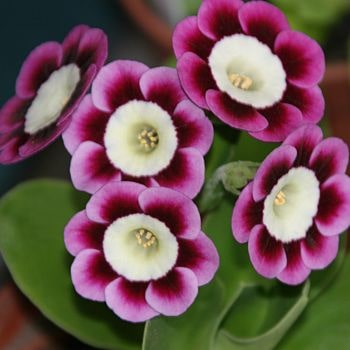
Ian Greville
There are some venerable plants available here, led off by Argus, hailing from the early dawn of the Alpine Auricula as a florist’s plant in the 1890s. It was a top variety for many years and of a unique shade, described by Newton as dark plum, shading to veinous red. It has it’s faults, but no breeder has managed to approach it's colour. Nor has the modern Argus the vigour to produce the trusses of yesteryear.
Next can be seen Roxborough, a purple light centre from the early years of the twentieth century and most famous as a parent of Gordon Douglas which was a serial winner through into the 1970s. Another from the Douglas nursery is Phyllis Douglas raised around 1908. It seemed to make a comeback but don’t expect anything of it now.
Next, we have a range of youngsters that are only approaching their centenary year! These are C W Needham, Joy, Frank Crosland and Lady Daresbury, all likely to have been raised by Percy Johnson in his role as gardener to the gentry during the 1920s and 30s. C W Needham is a dark blue, shading to purple, very distinctive but often with a poor centre. Joy won many Premiers and, like the others continued strongly into the 1970s and 80s. It is thought to be a seedling from Argus, although perhaps a touch more crimson. Great plants in their day, but you will be lucky to get a decent truss now.
Frank Faulkner concentrated more on the Gold Centres, but the Light Centred Margaret Faulkner was one of his best. In shades of purple, it was a favourite of Arthur Delbridge who had many battles with Derek Telford on the Alpine benches. Sandra used to be a favourite of mine. Raised in the 1970s it is a purple shading to pink which has won a number of Premiers. A nice pink is Rowena, raised by Jack Stant, a Leeds grower, in 1967.
All of the above are now at least 50-60 years old. They may still offset well but you could be struggling to produce a show size plant which will put up a decent truss. Probably more reliable are the numerous Light Centres produced by Derek Telford through the 80s and 90s. There are still many peppered through the nursery lists. They may not be as vigorous as they used to be, but they are worth a go if you cannot get the more modern varieties. I will just list a few here rather than try and describe the colours as they can be seen on the websites: Cambodunum, Averil Hunter, Divint Dunch, Lisa, The Venetian, Soncy Face, Langley Park, Douglas Bader, Elsie May.
What are the modern varieties that you should look out for? In the pink shades the most reliable variety over a few years has been Ian Greville raised by Cliff Timpson from the Midlands about 30 years ago now. More recently we have Calcaria and Uncle Eric. This latter variety and Dave Skinner’s Lois Mae, another pink featured strongly at this year’s Show. Sophie from Ken Bowser has deeper pink and purple shades.
In the blue shades we have Blue Yodeller and Dilly Dilly. This variety has been around for some time now and is widely available. It can come custard centred, but this often fades to an acceptable white. Of a much deeper blue are Quarry Lane and Eggborough which is another of Dave Skinner’s power station names. For purple we can look to Stella South, Highland Park and Lucy T. Some of these don’t look to be in commerce yet, but may well come up at Northern plant sales.
Gold Centred Alpine Auriculas

Dragons Hoard
A change of scene now as we move from Show Auriculas to Alpine Auriculas.
Show Auriculas are characterised by the circle of dense white paste on the eye, in Alpine Auriculas there must be no farina present on any part of the plant. So the eye of the Alpine Auricula is just the ground colour of the pip, either gold or deep yellow for the Gold Centres or white for the Light Centred Alpines. Some varieties are in between and are called ‘custard centred’, but they are not highly regarded. This body colour seen in the eye, carries on behind the shaded pigmentation of the Alpine pip to affect the colour range of the two types. The yellow body colour of the Gold Centres produces colours from a beige -yellow through to a deep crimson. The white body colour of the Light Centres produces cooler shades from pale pink to deep purple. In all cases there should be a smooth gradation of colour from a dark to light shade from the eye outwards.
In general the Alpine Auricula is easier to grow and more floriferous than the Show Auricula and this is reflected by the much wider range available at the specialist Nurseries. Although later on the scene than the Show Auricula they have attracted many more breeders since the late nineteenth century and the turnover of the Alpine varieties is greater. This is reflected in the Nursery lists where many varieties offered are rarely seen on the Showbench although favourites in their time. This would include the Gold Centres, Bookham Firefly and Prince John, now around 100 years old.
Of the Crimson Gold Centres, Bookham Firefly is the oldest offered. This was superseded by the varieties bred by Frank Faulkner in the 50s and 60s. Winifred was the most successful although most seem to have been short lived. Elsewhere, Blossom came along around 1960 and Applecross and Sandwood Bay from the 1970s are still available. Although serial winners in their time they are now rarely seen. Nowadays, Blyth Spirit is probably the best listed, although the newer Fraser is becoming available and worth keeping an eye out for.
Particularly attractive are the orange shades. The best of these is Vera, a lovely bright, deep orange. I cannot see it available commercially but it has been around for a while so may appear in the Northern plant sales. Others are not so bright and are older, such as Janie Hill, Andrea Julie and Rab C Nesbitt. After that there are some good varieties that are more orange-yellow, such as Toffee Crisp, Gail Atkinson and Gas lane. The range of colours proves almost impossible to follow through as they more towards yellow orange, with perhaps Dragon’s Hoard being the best available. Others to mention are Ancient Society, which is available although now perhaps not as popular as it used to be and First Lady perhaps the best of the bunch but I cannot see it listed.
The range continues where, instead of shading to yellow, it goes towards brown. Some of these can be rather dull although it is important to remember that the truss is judged on form and freshness, not on colour. There are varieties that shade to a rich brown, such as Sonny Boy, and others that have a touch of olive brown like Jerry Thomson, a recent Premier and the older Lee Paul. This brings us back round to Sirius, our beige -yellow and a parent of Lee Paul. I have attempted to give some idea of the large range of Gold Centred Alpines including those that I can see commercially available and more modern varieties that are not. The Northern growers do make an effort to get the newer varieties into our plant sales so it is as well to keep your eyes open and get them when you can.
Next month we will look at the Light Centred Alpine Auricula.
Any Other Colour Self Show Auriculas

Doug Lockhead
Intended as a catchall for those Self colours and shades not encompassed by the four main classes, Yellow, Red, Dark and Blue, this class was historically not highly regarded being filled by poor quality Selfs that were often quite dull. Yet more modern breeding often led by my father specifically concentrated on these 'offbeat' colours. We don't have to go back far to find a good starting point. We can look to Moonglow, raised by David Hadfield as recently as 1974. Although bred from a yellow cross this is a near white of good form and exceptional constitution and became the mainstay of the class for several years.
In the 1980s, my father crossed Moonglow with Moneymoon, a pale yellow of his own raising, to produce Limelight. This is near white with a greenish tinge on opening. Better quality than Moonglow and capable of producing a good truss of flowers, it replaced Moonglow as the main AOC. It could also compete with the other Selfs and I remember that superb exhibitor Richard Westwood including it in every one of his multiple classes to win the Show trophy. Around the same time, dad raised Twiggy which has a touch more yellow in it and as Limelight became less reliable, Twiggy has come to dominate. Not quite as good a form as Limelight but a serial winner.
Pink was another colour championed by my father. Using the old Douglas variety Rosebud he produced three varieties; Taffeta, Chiffon and Chanel that provided a definite colour break. Taffeta is still available and has been a mainstay of the Auricula nursery trade for several years. I got on the bandwagon and crossed Chanel with both Brompton and Sherbet Lemon to produce Eaton Dawn and Miss Otis. Eaton was the top AOC for a few years although it is difficult to get on the Show bench these days. Miss Otis is a more delicate pink and wins on her few appearances but hasn’t been in commerce to my knowledge. Strawberry Fields comes into this category, raised by John Cattle from my dad’s seed. It is not a red, being more of a crushed strawberry colour. The truss can be rather crowded, not allowing the pips to fully open but it is a reliable flowerer, wins regularly and is available.
I have already mentioned the purple varieties, Lilac Domino, Joel, Michael that belong here rather than the Blue Self class. Lilac Domino is the best and all 3 are available. Another, of a lighter shade of purple is Cut Silk from Andy Kemp. This is prolific and easy to grow although it can grow rather tall and leggy. It should be in commerce, but I haven't seen it.
Whistlejacket is one of the quality plants of the AOCs and the only show standard brown Self. Again, my father kicked these off with a whole gamut of different browns out of one cross, but none quite made the grade. I obtained a couple and crossed them, and this lovely brown was the only seedling that came up to standard. It is known for being difficult to get 5 pips on, but it is improving, and it was shown with a majestic truss of 7 pips a couple of years back. This has been in commerce and was in heavy demand a few years ago. Not so much of it around now, but still available.
The most striking AOC of them all is Doug Lochhead, a glowing orange red from an Eaton Dawn x Royal Mail cross. A fitting tribute to a larger-than-life character who ran Field House Nursery with Val Woolley for many years. The only seedling that I know from Doug Lochhead is Henry Pugh’s Brick Lane which is a nice terra-cotta shade although it may not be in commerce.
Next month we will look at the Alpine Auricula.
Blue Self Show Auriculas
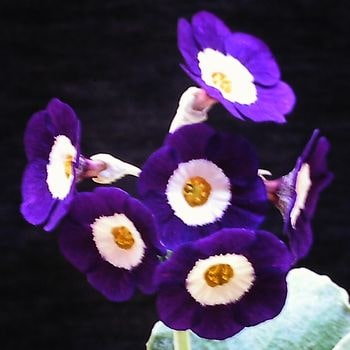
Prince Bishops
Blue has always been the most difficult colour to define. Our best efforts to date can only be called 'horticultural blue' and can be difficult to defend to an outsider. Yet if they are stood next to a purple self the blue can immediately be seen. Because of the lack of new varieties in this Class, Purple Selfs such as Joel and Lilac Domino are creeping in when they should be shown as Any Other Colour.
The Blue Selfs have another problem because they invariably have a pale tube, losing the contrast of the body colour with a yellow tube shown by the other Self Classes. They can initially have a lemon tube but as the pips ages this rapidly fades together with the intensity of the body colour.
One of the most famous 'blues', Mrs Potts, raised by Sam Barlow in the late 19th century was purple as can be seen from a reproduction of a painting in the 194? Yearbook. Another old variety is Blue Fire came from the Douglas nursery around the 1930s, yet is still listed by one nursery. It has more blue in it than Mrs Potts but is still nearer purple to my eyes. My father had this micro propagated by Wye College in the 1980 and this increased its availability but did not rekindle any magic.
Bloxham Blue from Oscar Moreton created a sensation when shown at the 1956 Northern Show. The result of much breeding, it was a colour break which promised much but faded too soon. Peter Ward expressed his surprise at finding it aconite violet (on the RHS colour chart). It has however been used extensively in breeding.
One of my favourites was Everest Blue, raised by Harold Hall in the 1950s. It was a regular winner into the 1980s and I remember that the truss tended to flower to one side. It vanished for several years, presumed lost, but then re-emerged from down south to win once again and is still apparently available. Perhaps perversely, I find it difficult to accept that it is the same variety and cannot rekindle my old love for it. Stella and Blue Nile raised by Robert Newton are both Bloxham Blue seedlings. Stella was the most striking of the two and both have been used extensively in breeding although a poor constitution has made them difficult to get on the Showbench. Blue Nile is still available and worth having a go with.
Undoubtedly the most dominant blue from the 1970s is Oakes Blue raised by Derek Telford. I can picture it shown by David Hadfield with 11 pips set in an even head of pips, as blue as we can get. David was an exceptional exhibitor, but it did reliably put up good trusses for over 20 years. No blue has come forward since to reliably replace it. Possibly my favourite more recent blue was Prince Bishops from Trevor Newton. He raised several blue seedlings using a seedling from Stella and an outcross to Moonglow. Maybe because of its parentage it appeared as a brighter blue, even hinting at a yellow tube. Very difficult to get on the showbench and possibly inhibited by its Stella parentage it seemed to fade away too soon.
My own pale blue breeding programme culminated some years back with Windermere. It could stand its own in multiples but is slow to offset and I only have one plant left. The only blue that I grow these days is El Zoco from Steve Popple down South. This is perhaps the nearest to Oakes Blue in colour that we have at present. I cannot see it in commerce, although it offsets well, and has been available in Northern plant sales.
Next month we will look at the Any Other Colour Self Show Auricula.
Dark Self Show Auriculas

Lampblack
One variety, The Mikado dominated this class for many years. First shown way back in 1905, it has made many come backs and I wouldn’t be surprised if it wasn’t still around. It was near black, with a slightly irregular head of pips on a long scape and with virtually green leaves; unusual in the Selfs, where farina is looked for to add beauty.
It was the 1950s before it had any challengers, when Neat & Tidy and Nocturne came along from Haysom seed. Neither had quite the quality of The Mikado, but Neat & Tidy was very reliable and so prolific that at one time you could get it for 10p. Nocturne was supposed to be more refined although to be honest it was difficult to tell them apart. Both produce a good head of pips on a shorter scape than the Mikado and, despite their 70 years are still around and listed by the nurseries.
Derek Telford raised a number of Dark Selfs in the 1970s, most tending towards dark red including The Snods, Neville Telford and Gizabroon. The latter seems to be quite a popular variety again now although these shades are slightly indeterminate, lacking the striking black of The Mikado and Barbarella and I believe that at one time they were called ‘Smokies’.
It took Peter Ward’s Barbarella to finally knock The Mikado off its perch in the 1980s. Vigorous and with a tall stately truss that could hold many quality pips that were near black. It still wins the dark Self class regularly although after 40 years it does not have the vigour that it used to. It is listed and should be available. It was not quite a knockout blow however because a good example of the Mikado could still give it a run for its money.
Next come plants named after dogs! My father’s Wincha was named after a friend’s poodle and is another variety which is still listed after 30 years. Probably from Barbarella it is not quite as good, but still wins on the Show bench and is worth a go. Erjon was one of Trevor Newton’s dogs, providing the name for this quality, near black Self, of good form. It could have been as good as Barbarella but proved more difficult to grow and increase. When Trevor showed his own seedlings there was nothing to touch them.
Lady Zoe from Jack Cooke must be even older and didn’t create much of an impression at the time but seems to have made a comeback as Barbarella has become less reliable. A good head of near black pips it makes an attractive plant.
I should perhaps mention my own Lampblack which has won the Dark Self class a time or two. It is a sister plant of Jet Black which won a Premier at the Midland & West in 2011 and itself won their Seedling Cup in 2012. Jet Black started to come wavy in the pip and I haven’t even got it now, but Lampblack has increased well and may now be the best dark self. The scape is tall and the developing truss looks insignificant but it can develop into an impressive head of bloom. As far as I am aware it is not in commerce, but a few have been put in the Northern plant sales.
Next month we will look at the Blue Self Show Auricula.
Red Self Show Auriculas
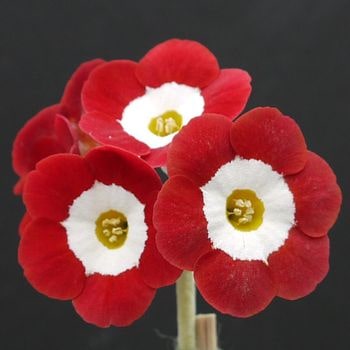
Knights
I consider the Red Self to be the doyen of the Selfs, because of their richness and intensity of colour. They have a long history, and I was surprised to see this manifested in one nursery list in the form of Fanny Meerbeck. Raised in the 1890s, this was old when I first started growing. Its parentage is unknown, but it has been known to throw a yellow pip, or a red pip with a yellow stripe in it. Next in age comes Alice Haysom, listed by two nurseries, raised in the 1930s, a brighter red but lacking in quality. It is good that nurseries continue to stock these varieties, even though superseded, because I know that there are many reasons why people are looking for varieties other than putting them on the show bench.
We are fortunate with the Red Selfs because there does seem to be a good range listed, including quality varieties, although these are too often marked 'out of stock'. There are middling ones like Redgauntlet, Mohave, Lechistan and Favourite that have either had their day or were not quite good enough in the first place. Then there are more modern, quality varieties, like Scorcher, Royal Mail and Simply Red, the latter perhaps lacking in brightness.
Geronimo is also still available. In the 1970s Geronimo and Cheyenne were the dominant reds. Both were raised by Peter Ward and were virtually identical. Of great form they won many prizes over several years, but they lacked brightness, and the search was on to find a brighter red. This took several years, often involving Pat which was a bright red but also had faults that carried into its offspring.
It was Trevor Newton from the Northeast who made the break though with his Red Sonata and Red Ember, bright reds of good form. I haven’t seen these for a few years, but they did enable my father and myself to cash in with our own bright red varieties, principally Scorcher and Royal Mail. Both are still available; Scorcher is the brightest and a reliable flowerer whereas Royal Mail has slightly better form but has been more difficult to get on the show bench.
Trevor, however, had the last laugh, as, in the mid-1990s, he made a yellow x red Self cross to produce Knights. This has remained the dominant Red over the last 20 years. It grows well, offsets readily and can be relied on to produces a good truss of pips held well above the foliage. Given this, I was surprised to find that it didn’t seem to feature in any of the Nursery lists that I looked at. But keep looking for it because it is worth the wait.
Trevor continued to produce Red Self seedlings, mostly using Knights as a parent but none have become established to date and are unlikely to be in commerce. Likewise, Bob Taylor has produced some good quality seedlings of a rich red colour. These are still being grown on and much hybridisation is underway to make new Red Self varieties available.
One issue that can be contentious with the Selfs is where the boundaries of the recognised Class colours lie. Within the Red Selfs, Dark reds can look sumptuous, but do not fit easily into the class, the darker ones maybe qualifying better for the Dark Self Class. Likewise, a touch of pink tends to detract from the intensity of colour in the Reds and moves the variety towards the Any Other Colour class. A tinge of orange is acceptable, and this can be noticed if you compare Scorcher with Royal Mail.
Next month we will look at the Blue and Dark Self Show Auriculas.
Yellow Self Show Auriculas

April Moon
Looking over the websites of those nurseries selling Auriculas I was surprised to find how few Yellow Selfs are listed and how far too many of the varieties in general are either Sold Out, not available or not yet ready for sending out. Neither would I hold forth the Society as a saviour, as there are few large collections of Show Auriculas still around and even these are at the mercy of the increasingly unpredictable weather. However, getting together a good collection of Auriculas has never been easy and persistence will pay dividends.
The Yellow Selfs should be the most numerous, being the colour of Primula auricula itself. Yet in Primula pubescens, its natural hybrid with Primula hirsuta, the petal becomes pigmented with the purple hirsutin. This combination was used by the hybridists to create the range of colours that we see in the modern Auricula. But it then became difficult to fix a true yellow in acceptable form. There were early yellows, yet even in the early twentieth century the class included maize and other impure shades. It could be regarded as coming of age with two varieties from Cyril Haysom in the 1950s, Ower and Melody. Others soon followed with Leeside Yellow from Dr Newton and Goldilocks and Queen of Sheba from Fred Buckley.
By the mid-seventies we had two of the finest Yellow Selfs ever raised, Tracy Ward from Peter Ward and Brompton from David Hadfield. Tracy Ward unfortunately faded away too soon, but Brompton dominated the class for many years. Both Peter and David used a Yellow Self to leaven the Edged plants that they put up in the multiple classes and make the entry more representative. Upton Belle, raised 50 years ago from unpromising parents, was not far behind in quality; it had an opulent flower but was an awkward grower and I haven't seen it for several years.
Forty years ago, my father, Tim Coop made a cross which provided us with many of the Yellow Selfs for the years to come. This was Moonglow x Helen, and it produced, April Moon, Corntime, Party Time, Lemon Drop, Moneymoon, Tomboy and Sherbet Lemon. The use of Moonglow, which is pale enough to be classed as an 'Any Other Colour' caused these to be of a paler shade than many previous yellows. A number are still around, including Helen; April Moon was probably the best, but Sherbet Lemon had petals like satin. Corntime seemed to develop later than the others and Chris Gill used it several times in his Show multiples.
Brasso, from my father, came slightly later, from Moonglow, but this time crossed with Upton Belle, the cross producing a reliable bright yellow. Brasso has stood exhibitors in good stead for the 'Matched Pair' class at the Midland and West Show, readily producing a good truss held well clear of the foliage.
Another raised about the same time was Golden Fleece from Les Kaye. This again is a bright yellow and looks to be still available. The one that maybe easiest to obtain is Piccadilly from Henry Pugh which is listed by more than one nursery. Ken Bowser's Sharon Louise has the best form of our modern Yellow Self, and has won many prizes. It has however always been a bit chary of offsetting and you will be very lucky if you get a plant.
If you are struggling, then nil desperandum; The Baron looks to be still available. It is more of a maize colour, but I have a picture of my father and I from 35 years ago, looking askance at a large and good quality Yellow Self class won by 'The Baron'!
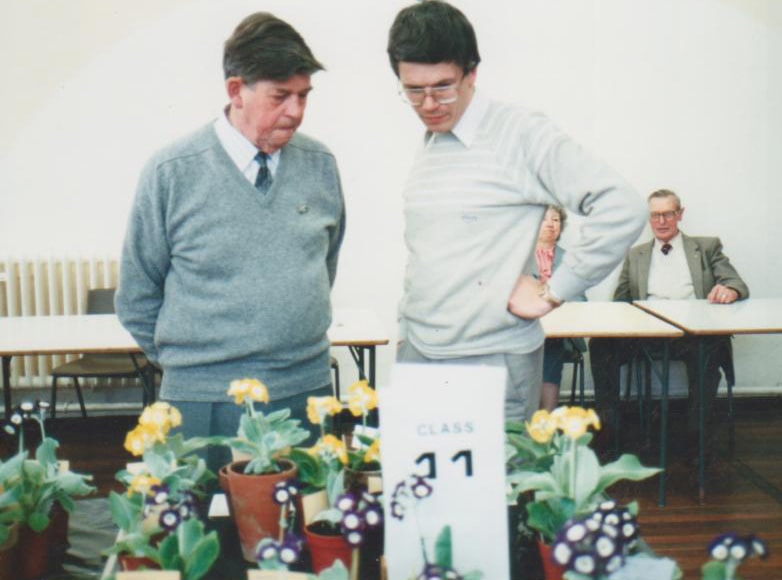
Tim and Brian Coop
Next month we will look at the Red Self Show Auricula.
Grey/White Edged Show Auriculas
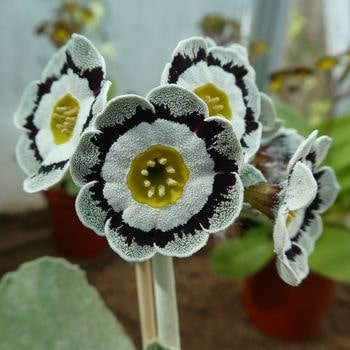
Mike Seel
Last month I hinted that these types were prized above the Green Edges by some because both the foliage and pips are covered with tiny little filaments which form the farina. This varies in consistency, by variety, from just a thin smattering over the green to a dense white paste. It is this contrast between the white edge and the black body colour that make these such striking plants. Those still showing the green underneath are not so highly prized. Others are on the borderline and can be shown in either the White Edged or Grey Edged classes.
As with the Green Edges, body colours other than black are acceptable in the Open classes, but there are none that have yet been bred to that standard and need to be shown in the Fancy classes. All Edged auriculas have body colour that flashes to the edge at times, purple, red, pink or yellow, the main criteria being that the contrast is striking.
We are still too dependent on the varieties raised by Peter Ward nearly 50 years ago and of these, Warwick and Gavin Ward have not been surpassed. Warwick still offsets well but is not as vigorous as it used to be and is difficult to grow to Show standard. Gavin Ward was always more chary of producing offsets, but the individual plants seem to sustain better than those of Warwick. It has won many Premiers although slightly let down by a crenated tube.
Of Peter’s others, Clare is probably the best although it is variable in form and its crenated tube can be too wide. Sharman’s Cross is nearer white and is above average, but it can be difficult to get a well formed truss. Brookfield is nearest white and probably because of this the pips tend to be smaller, the density of farina inhibiting their growth. It also has a tendency to produce a small supernumerary petal which upsets the symmetry. Having said that, it still wins on the Showbench and may be the easiest to obtain.
Of the true whites, James Arnot and Walhampton are probably now in the past. Ptarmigan can be a winner but is not easy to grow. Michael Wattam may be the easiest to obtain but is hardly of show quality. More recently Allan Guest has raised some White Edged seedlings, of which Mike Seel, named after an organiser of the Saltford Show, looks to be winning a prize or two.
Bob Taylor, past secretary and editor of the Northern Society raised a number of Greys which he named after Dad’s Army characters, including Corporal Jones, Sergeant Wilson and Pikey. Pikey is probably the best and has persisted longest. It is not an easy plant but should still be available.
There is another type of Grey where the beauty seems to be created by the underlying petal colour rather than the density of meal. Here, the edge looks to be leaded or like pewter, apparently dull, but making a variety of striking contrasts. The best of these, raised by David Hadfield, is Grey Hawk. It is more recent than some of the varieties mentioned here but is of a poor constitution and faded years ago.
A more recent example is Chris Gill’s Sea Peep. It is not of the same quality as Grey Hawk and the pips are smaller but it has this strange beauty and, more importantly it forms a good truss and is appearing in more exhibits. It is definitely worth obtaining.
Next month we look at yellow Show Selfs.
Green Edged Show Auriculas
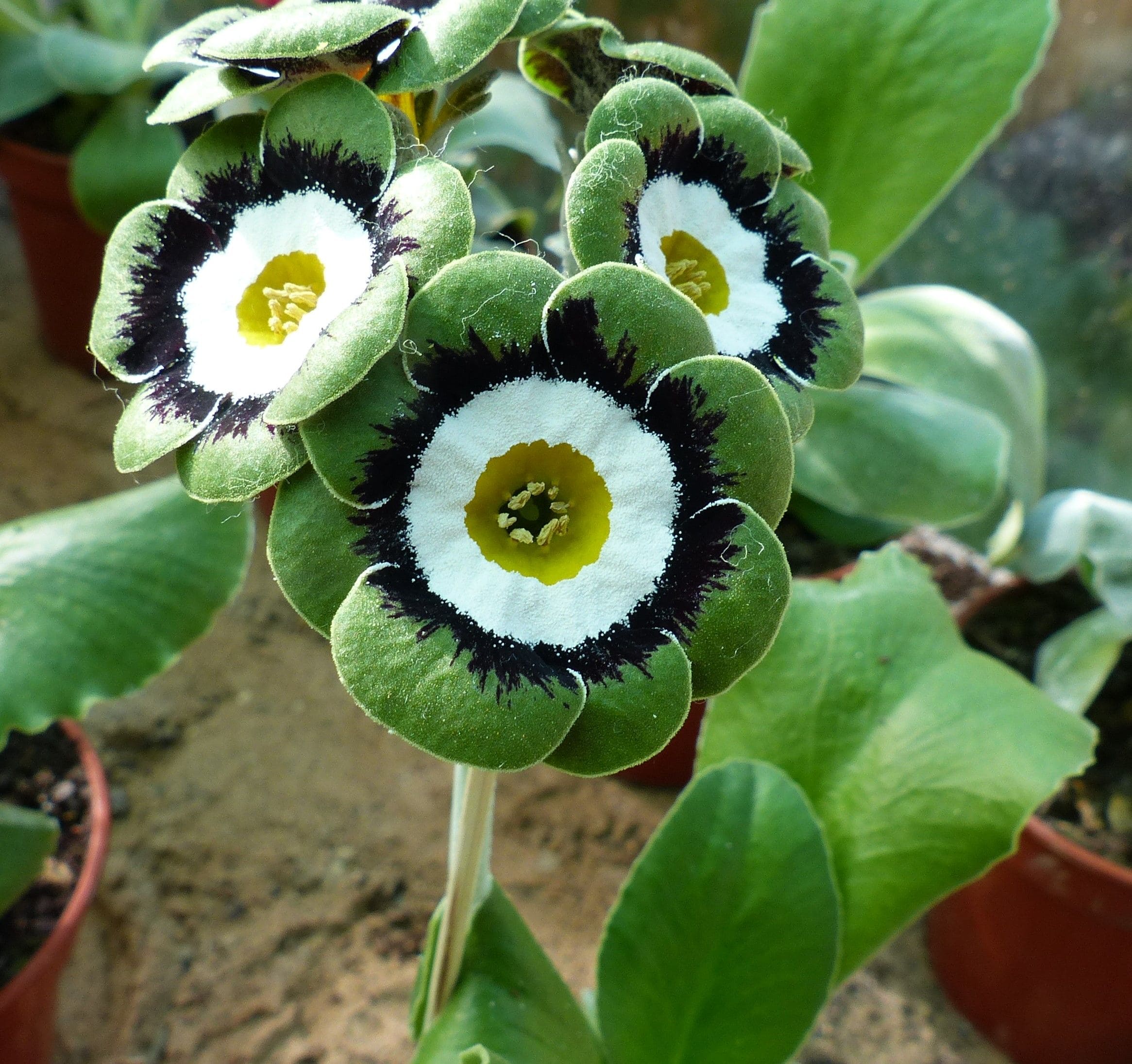
Prosperine
The Green Edged Auricula must be regarded as the acme of the Florist's art because of the way they have turned the chance occurrence of virescence in the pip into the refined green edge. Some regard the Grey/White Edge as more beautiful, and we will look at them next month. Many find them difficult to grow to Show standard and, as the Stripes and Doubles of the 17th and 18th century have been resurrected, growers have moved towards them. Others prefer just to grow the Show Self but not the Show Edged although the Show multiple classes are supposed to be representative of the type as, despite appearances they are closely related.
This can be seen in breeding where, despite 200 years of crossing Green Edges with one another, each cross will still produce Selfs, sometimes up to 25%. Equally a quality Green Edged, if not well grown will manage 2 or 3 good pips but will then run out of energy and the later ones are deficient in edge, showing too much body colour, moving towards a Self.
The body colour of most modern Green Edges tends to be black, or deep red, but it can be red, as in Rajah, violet as in Helen Barter, pink as in Astrolat or yellow as in Salad or Spring Meadows, with many others varieties available commercially. The problem is that all of these have body colour that flashes to the edge and are therefore classed as Fancies, because they do not conform to the Standard. Although Edges of other body colours than black are accepted in the 'Open' classes nobody has, to date, succeeded in raising one to that standard.
In recent times the peak of popularity was probably reached 40-50 years ago when the varieties Chloe, Fleminghouse and Roberto became more widely available and were shown in quantity. Certainly, Chloe and Roberto are still around although Chloe is losing vigour.
For 20 years up to 2000 we largely had to depend on the Northern Secretary, David Hadfield for keeping the Green Edges going as he raised superb varieties like Prague, Jupiter, Figaro and latterly Sappho and Tamino. These varieties are still in existence and may appear in commercial lists. Sappho was the top Green Edged up to 5 years ago. More recently, Bob Taylor raised quite a few Green Edges including Gruner Veltliner and Moselle during the 80s and Clipper in the 2000s. These again should be available from nurseries although they have the same problems in bulking stocks up as the amateur grower and will soon sell out.
My own efforts started with Benny Green around 25 years ago and this is listed commercially. It has been a reliable winner on the Showbench during that time although it can be difficult to get with more than 5 pips and maybe now past its best. Septimus Green was bred from this and is better, a reliable grower with more pips and better quality. To my knowledge it is not available commercially, but a number have been made available through Northern plant sales.
The other main contender is 'Prosperine', raised by Ken Whorton over 20 years ago. It is a small plant of excellent form which has won many awards and seems to be gaining in popularity.
So the number of show standard Green Edged varieties available is limited. There are many others that have been raised and fallen by the wayside over the years that still remain in nursery lists but I would not recommend them for show purposes.
The Auricula Scene
Brian Coop
As we leave behind the celebrations of our 150th Anniversary, it seems an appropriate time to assess where the Auricula stands at present. Over the next few months it is planned to run through the different classes of Auricula and advise on what is available and worth growing for showing. We already have an overview of the 'Types of Auricula' on the website, so the classes are those seen in the Show schedule e.g., Green Edged Auricula, Gold Centred Alpine, Double or Striped.
As we are a Florist's Society I will be looking at the varieties within these classes which meet the accepted Standards. I will include Border Auriculas which are judged for effect rather than to Standards. Gold Laced Polyanthus are also an important florist's flower within our Society although I will certainly have to seek advice on these.
I am aware that we have many new members within the Northern Society who wish to get started with exhibiting and are frustrated by the lack of quality material. The advice to new growers wishing to exhibit always used to be to look in the recent yearbooks to see which varieties have won on the Showbench. Yet within the last 10 years we have lost three specialist Auricula nurseries and the numbers of senior growers maintaining good collections has been thinned.
There are still a number of Nurseries that list large numbers of Auricula varieties to meet this increasing demand. Although top varieties may be listed there they are not quick to propagate and may be soon sold out. Otherwise there are many varieties that have been superseded, deteriorated through old age or which have never been successful on the showbench.
The main advice we can give is to get involved, go to the Shows, and have a go in the Beginner's classes. There is no harm in buying a general collection of Auriculas and showing them to the best of your ability. It is better to show an average variety in good form than a top variety poorly. This will be recognised by the established growers who will seek to encourage you and make the better varieties available.
